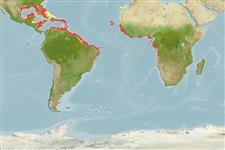Common names from other countries
Environment: milieu / climate zone / depth range / distribution range
экология
морской ассоциированный с рифами; пределы глубины ? - 650 m (Ref. 3686), usually 50 - 300 m (Ref. 26999). Subtropical; 30°N - 14°S, 98°W - 15°E (Ref. 34024)
Western Atlantic: off the continental coast from Florida, USA and the Gulf of Mexico to northern South America, including islands in the Caribbean. Eastern Atlantic: off Senegal to Angola.
Size / Вес / Возраст
Maturity: Lm ? range ? - ? cm
Max length : 94.0 cm TL самец/пол неопределен; (Ref. 40637); common length : 50.0 cm TL самец/пол неопределен; (Ref. 5217); наибольший вес (опубликованные данные): 8.5 kg (Ref. 40637)
Краткое описание
определительные ключи | морфология | морфометрия
колючие лучи спинного плавника (общее число) : 0; членистые (мягкие) лучи спинного плавника (общее число) : 109 - 117; колючие лучи анального плавника: 0; членистые (мягкие) лучи анального плавника: 86 - 90. Body completely covered with small, imbricate, cycloid scales; barbels present on snout (6) and chin (6); branchiostegal rays 8; median basibranchial tooth patch absent; developed gill rakers on first arch 4 or fewer; pelvic fin rays inserted at about level of preopercle, well behind eye (Ref. 34024). Ventral fins dark, gradually becoming darker at the extreme blackish edge (Ref. 13608).
Common species (Ref. 34024). Adults benthopelagic (Ref. 34024) down to 650 m, but most often on the continental shelf (Ref. 3686), on sandy and muddy bottoms (Ref. 2683). Juveniles common in reefs (Ref. 34024). Smaller silvery specimens taken far out at sea in the epipelagic (Ref. 34024). Oviparous, with oval pelagic eggs floating in a gelatinous mass (Ref. 205).
Life cycle and mating behavior
Maturities | размножение | Spawnings | Egg(s) | Fecundities | личинки
Nielsen, J.G., D.M. Cohen, D.F. Markle and C.R. Robins, 1999. Ophidiiform fishes of the world (Order Ophidiiformes). An annotated and illustrated catalogue of pearlfishes, cusk-eels, brotulas and other ophidiiform fishes known to date. FAO Fish. Synop. 125(18):178p. Rome: FAO. (Ref. 34024)
Статус Красного Списка МСОП (Ref. 130435)
CITES (Ref. 128078)
Not Evaluated
Угроза для людей
Harmless
Использование человеком
рыболовство: не имеет хозяйственного значения; объект спортивного рыболовства: да
дополнительная информация
инструменты
Специальные отчеты
Скачать в формате XML
ресурсы в Интернет
Estimates based on models
Preferred temperature (Ref.
115969): 12.5 - 26.5, mean 19.7 (based on 331 cells).
Phylogenetic diversity index (Ref.
82804): PD
50 = 0.5156 [Uniqueness, from 0.5 = low to 2.0 = high].
Bayesian length-weight: a=0.00372 (0.00180 - 0.00768), b=3.15 (2.96 - 3.34), in cm Total Length, based on LWR estimates for this species & (Sub)family-body (Ref.
93245).
Trophic level (Ref.
69278): 3.9 ±0.6 se; based on size and trophs of closest relatives
устойчивость к внешним воздействиям (Ref.
120179): средний (среднего размера), минимальное время удвоения популяции 1.4-4.4 года (K=0.19).
Fishing Vulnerability (Ref.
59153): Moderate to high vulnerability (52 of 100).
Climate Vulnerability (Ref.
125649): High vulnerability (65 of 100).
